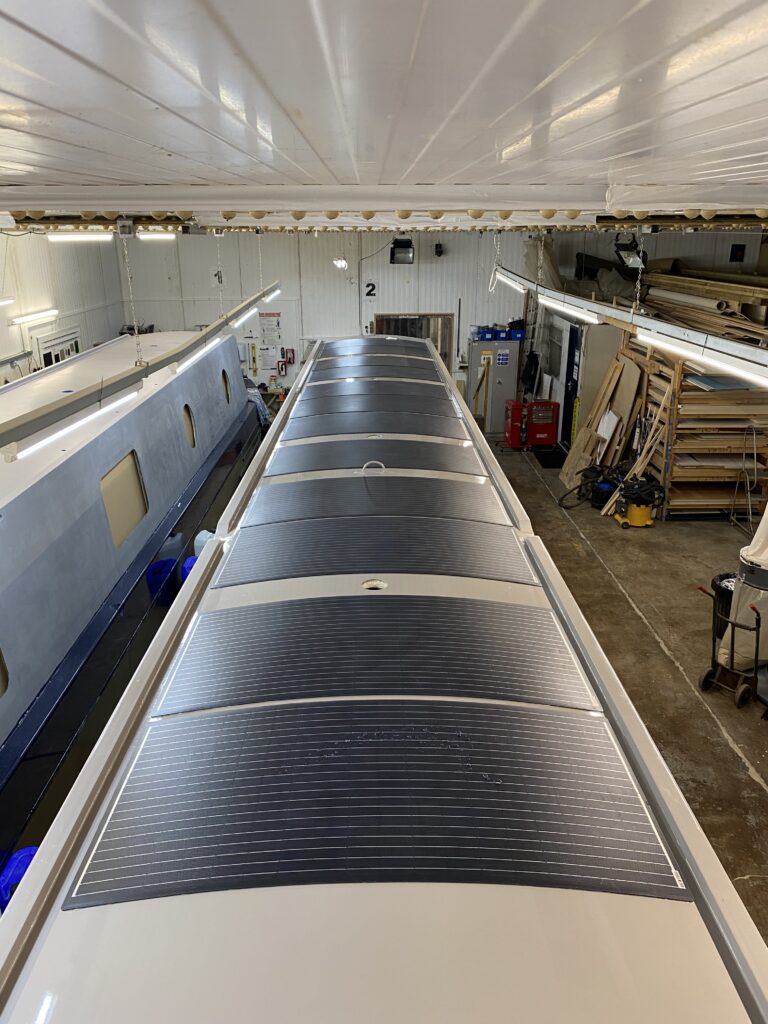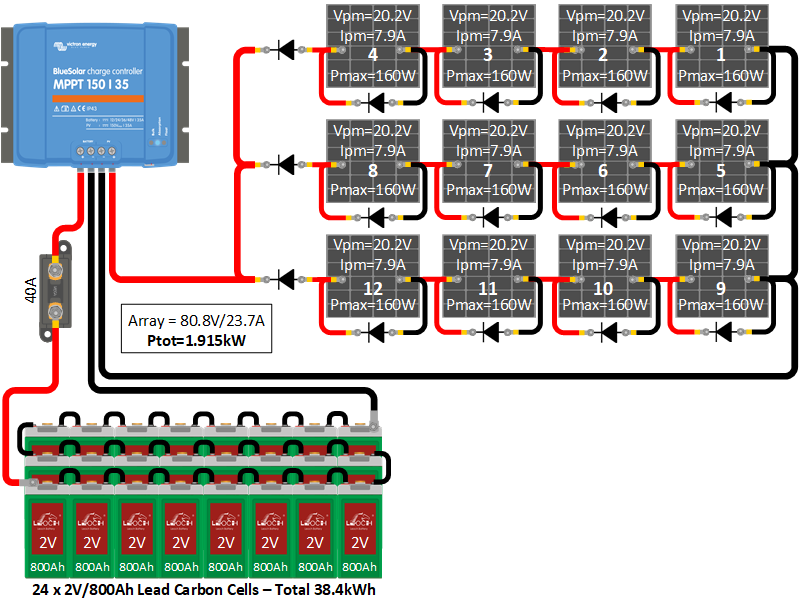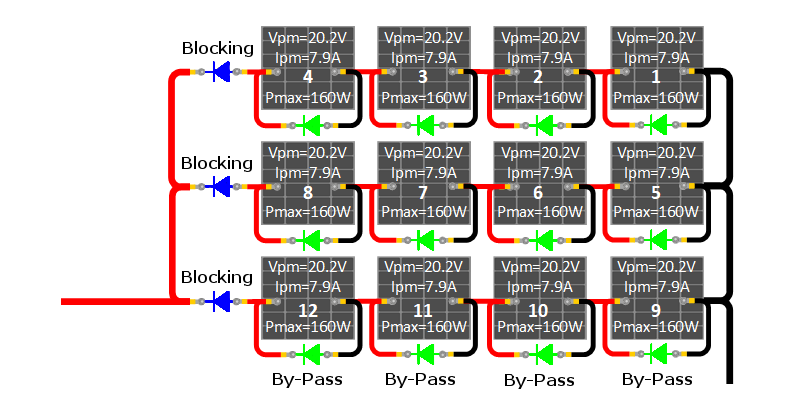This post is really a continuation and update of our original Solar Solution post, where we looked at how solar panel systems work. Now 3 months later, “Old Nick’s” solar system has been installed and is actually generating power, albeit fairly limited from the interior lighting of Ortomarine’s workshop.

Back in August, we were trying to decide whether to fit 8 panels (2 sets of 4) or 10 panels (2 sets of 5), which we decided against as it transpired that the solar panel manufacturer did not recommend having more than 4 panels in series.
At that time, we didn’t think we could fit 12 panels and still have room for the other paraphernalia that you normally find on a narrowboat roof…
- TV Antenna
- Mobile phone antennas
- GPS Antenna
- Gang Plank
- Boat Hook and Pole
- Ropes
- Chimney
- Air Vents
…but then we had a epiphany. Let’s get rid of all the paraphernalia!
This decluttering of the roof required some big decisions and also some creative thinking. First to go was the chimney for the solid fuel burner, which we had actually already decided was out, for other reasons. This was swiftly followed by the gang plank, which became a folding gang plank that we could store in one of the rear lockers.
Ropes, boat hook and pole, would need to be carefully positioned to avoid the panels, while the air vents (which we could not get rid of) fitted neatly between the panels.
That just left the antennas. When we started to think about our latest viewing habits, it became clear that streaming was far more important than live TV and so getting good mobile internet reception was our top priority.
With this in mind, we decided to fit two external high gain 3G/4G antennas – one either side of the hatch, to avoid using precious solar panel space. An added bonus was that we could order one of the 3G/4G antennas with a GPS antenna inside as well, so that took care of the position and timing data needed by the Victron Cerbo communication center.
Finally that left the TV antenna. Once we had decided that live TV was actually our backup plan, the idea of a temporary TV antenna was born. The concept was that if we happened to moor in an area with poor 3G/4G coverage, we could quickly grab the TV antenna and hook it up in less than a minute. I will be writing a separate post about how we achieved this goal, once “Old Nick” is launched, but it was the final piece of decluttering and we now had room for 12 solar panels.
The benefit of having 12 panels is not just the extra power that they supply, but that you have three separate sets of solar panels wired in parallel. As you can see from the diagram below, each set of 4 panels are wired in series so each set should generate 80.8 Volts and 7.9 Amps of current in full sunlight.

Courtesy of Rob Howdle at Ortomarine
When Ortomarine installed the solar panels, they intelligently placed one set of solar panels at the front of the roof, the second set in the middle and the last set at the stern. This reduces the chance of “shadowing” due to buildings, trees, etc. causing the power output of all three sets to be reduced at the same time.
With the three sets in parallel, the voltage stays at 80.8v (which is within the safe limits set by the solar panel and MPPT controller manufacturers) but the current is tripled to 23.7 Amps. As Power = Voltage x Current you get three times the power – a whopping 1915 Watts (80.8V x 23.7A).
As long as we choose our mooring spots with a little care, we can have the stern or bow in shadow but still achieve two thirds power output. Obviously there will be times when we have no choice but to moor in a location where we have full shading, but the hope is that this panel layout will work better in most situations.
As soon as you have multiple solar panels, you have the possibility of one panel failing, being disconnected or outputting less power or no power due to shadowing. In these situations, the voltage from the good panels can be dragged down or the current they produce will flow in to the bad panels causing them to over heat or even burn out. To protect against these situations, it is very important to fit suitable blocking and bypass diodes.
In the diagram above, you can see several diodes, indicated by the little triangle and bar icon. Put simply, diodes are the electrical equivalent of a non-return valve in plumbing. Basically a diode lets current flow in the direction of the arrow and stops it flowing back the other way.
Referring to the diagram below, you can see that the By-Pass Diodes (shown in green) are in parallel with each panel. Should a panel fail, be disconnected or blocked from the sun, then the current that would normally flow through the panel needs to go somewhere. The By-Pass Diode provides a route for it to flow through, ensuring that the rest of the panels in the set can still generate power.

The Blocking Diodes (shown in Blue) are each wired in series with the four panels they are protecting. Should a set of panels be in shadow and their voltage level drops, the Blocking Diode, in series with the poor performing set, stops the higher voltages from the other two sets being dragged down. As soon as the panels come back in to full sunlight, their voltage increases, current starts to flow through the Blocking Diode and they contribute to the overall power output again.
The 1915 Watts of power from the 12 panels, should be enough during the summer to allow us to cruise all day, just using the solar energy. The large bank of Leoch LC2-800 batteries (see below) will act as a buffer, coping with any sudden high demand for power from the Vetus E-Line 10KW engine, such as when moving off, stopping or manoeuvring, all the while being charged by the solar panels and the Victron MPPT controller.

The image above was taken just before the Vetus GLX6,5SIC generator was installed and we now have a fully installed electrical and propulsion system. The batteries are being charged and equalised and now Ortomarine can start installing the appliances that will use the power. It’s all really starting to come together. An exciting prospect!

Blimey ……..SSOOooooo much to think about ! It will all be very well worth it, and very soon too. Good luck !!
Dear Paul,
Thank you very much for publishing that. It very helpfully answers several questions that are significant for us: the maximum number PV panels a 60′ narrowboat roof can sensibly accommodate, how much they are capable of producing on a (very) good day, as well how much space a modern 48v battery bank occupies.
Our preferred propulsion option is the same as you’ve chosen, but we’re still pondering the question of whether or not any currently available electric motor has – in practice – the power drive a 60′ narrowboat at three or four mph (SOG) against a powerful contrary current on, say, the tidal Trent, Thames or the Ribble Link, for five hours or more continuously. We plan to spend about 25% of our time on rivers, some of them tidal, plus the very occasional estuary crossing. Is this something you’ve had to consider? Perhaps your cruising plans don’t require an answer to that question, but if you have one I’d be very interested to hear it, but only if you have the time and inclination.
Old Nick is going to be a wonderful narrowboat. I hope you have a huge amount of fun in her. With best wishes.
Hi Andrew,
With so little data around, we based our decision on NB Shine which we used as a benchmark. They have cruised successfully on the tidal Thames with plenty of power to spare and we decided to go for 33% more battery storage just to be sure.
Torque should not be an issue from an electric engine and 10KW should be enough power for most situations, although we will not know for sure until we start cruising on Old Nick. We will be publishing data on our experiences so hopefully this might help you make your decision – what are your time scales?
Best regards
PAUL
Thank you very much, Paul. We hope to find a build slot next Autumn/Winter, so it looks as if we may well be able to learn from your experiences next year, if you are kind enough to publish them.
One thing seems odd. According to the conversion tables 10 KW equals 13.5 HP (approx), which is around 30 HP less than most narrowboats’ engines. I must be missing something. Perhaps as several articles suggest, much of the output of a conventional diesel narrowboat engine is wasted. Maybe we need a modern version of the Rainhill Trials, or maybe the Rattler/Alecto races?
Thank you again for responding.
Fantastic blog and very helpful for us considering a new build electric boat. Can we have an update on the electricity generation you had since collection (over winter) and now that the sun is out? How much you found yourselves having to run the generator etc?
Thank you. That’s just what we hoped it would be. Funnily enough, I am mid-write on just such an article! Watch this space.